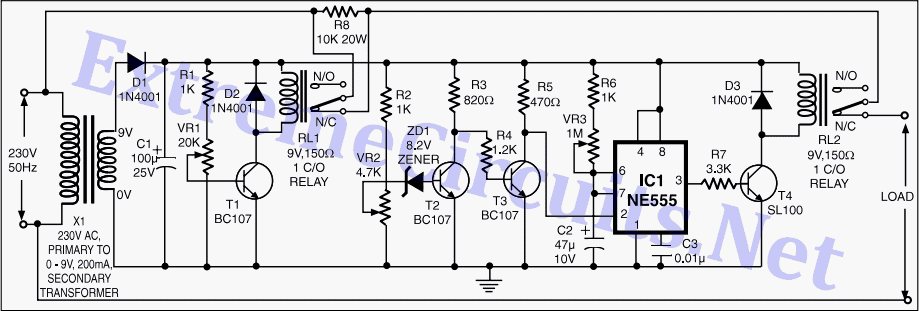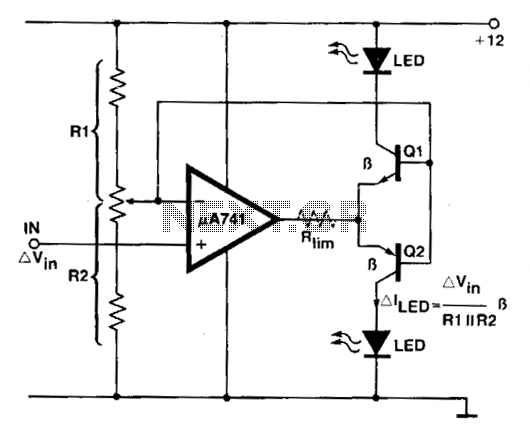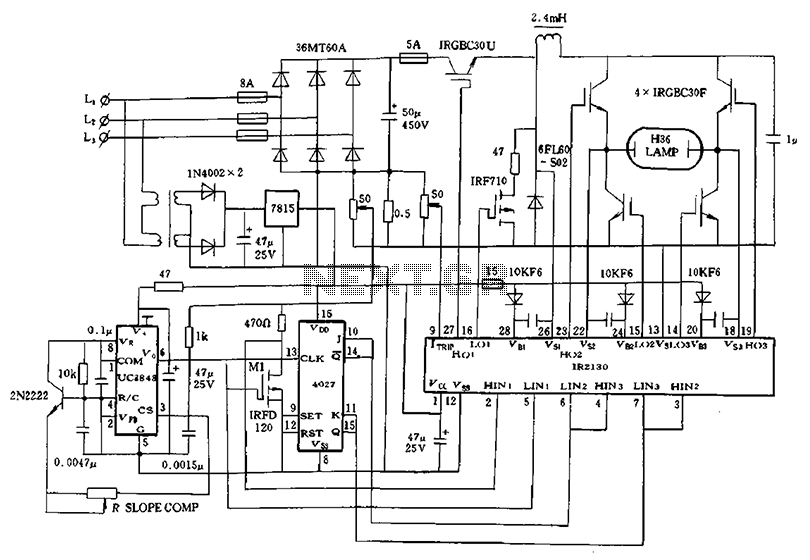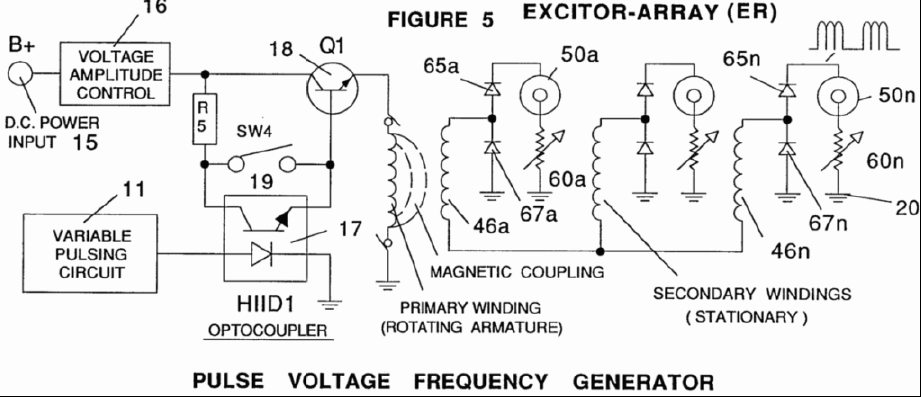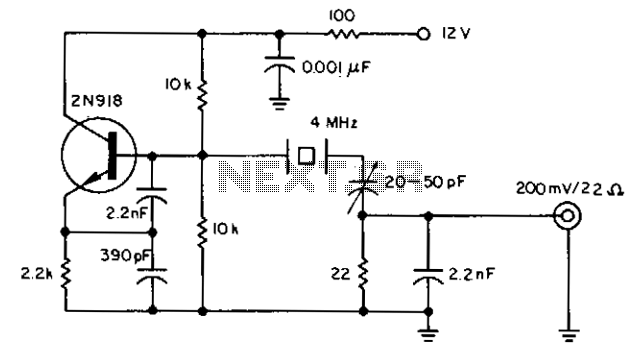
Low voltage lamp flasher
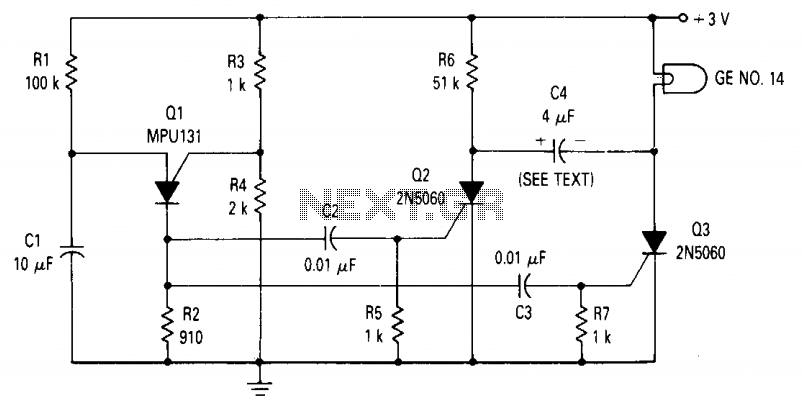
The circuit consists of a relaxation oscillator created by Q1 and an SCR flip-flop formed by Q2 and Q3. When the supply voltage is applied to the circuit, the timing capacitor C1 charges to the firing point of the Programmable Unijunction Transistor (PUT), which is 2 volts plus the diode drop. The output of the PUT is coupled through two 0.02 µF capacitors to the gates of Q2 and Q3. To clarify the operation, it is assumed that Q3 is on and capacitor C4 is charged from positive to negative as indicated in the diagram. The subsequent pulse from the PUT oscillator activates Q2, which causes the voltage across C4 to be applied to Q3, momentarily reverse-biasing it. This reverse voltage turns Q3 off. After discharging, C4 then charges with its polarity reversed. The next pulse from Q1 activates Q3 and deactivates Q2. It is important to note that C4 is a non-polarized capacitor. With the specified component values, the lamp remains on for approximately 1 second and off for the same duration.
The described circuit effectively utilizes a relaxation oscillator and SCR flip-flop configuration to control the timing of a lamp's illumination. The relaxation oscillator, driven by Q1, generates a periodic waveform that charges capacitor C1 until it reaches a threshold voltage. This threshold is determined by the characteristics of the PUT, which serves as a switching device in the circuit.
When the PUT is triggered, it generates a pulse that is coupled through the two 0.02 µF capacitors to the gates of Q2 and Q3. The operation of Q2 and Q3 as an SCR flip-flop allows for the bistable switching of the output. Initially, when Q3 is in the conducting state, capacitor C4 is charged in a specific polarity. The subsequent pulse from the PUT oscillator turns Q2 on, which applies the voltage across C4 to Q3, effectively reverse-biasing it. This action causes Q3 to turn off, interrupting the current flow through the lamp.
After Q3 turns off, capacitor C4 discharges and then begins to charge again, but with its polarity reversed. This reversal is critical for the next cycle of operation. The next pulse from Q1 then turns Q3 on while simultaneously turning Q2 off, allowing the cycle to repeat. The use of a non-polarized capacitor (C4) is essential in this configuration, as it allows for the capacitor to be charged in both directions without risk of damage.
The timing characteristics of the circuit, specifically the duration for which the lamp remains on and off, are primarily determined by the values of the components used, particularly the timing capacitor C1 and the resistors in the circuit. With the specified values, the lamp operates in a duty cycle of approximately 1 second on and 1 second off, which can be adjusted by changing the component values to achieve different timing intervals. This circuit design is beneficial for applications requiring controlled illumination or signaling, such as in flashing lights or timing indicators.The circuit is composed of a relaxation oscillator formed by Q1 and an SCR flip-flop formed by Q2 and Q3. With the supply voltage applied to the circuit, the timing capacitor CI charges to the firing point of the PUT, 2 volts plus a diode drop.
The output of the PUT is coupled through two 0.02 ^F capacitors to the gate of Q2 and Q3. To clarify operation, assume that Q3 is on and capacitor C4 is charged plus to minus as shown in the figure. The next pulse from the PUT oscillator turns Q2 on. This places the voltage on C4 across Q3 which momentarily reverse biases Q3. This reverse voltage turns Q3 off. After discharging, C4then charges with its polarity reversed to that shown. The next pulse from Q1 turns Q3 on and Q2 off. Note that C4 is a non-polarized capacitor. For the component values shown, the lamp is on for about Vi second and off the same amount of time.
The described circuit effectively utilizes a relaxation oscillator and SCR flip-flop configuration to control the timing of a lamp's illumination. The relaxation oscillator, driven by Q1, generates a periodic waveform that charges capacitor C1 until it reaches a threshold voltage. This threshold is determined by the characteristics of the PUT, which serves as a switching device in the circuit.
When the PUT is triggered, it generates a pulse that is coupled through the two 0.02 µF capacitors to the gates of Q2 and Q3. The operation of Q2 and Q3 as an SCR flip-flop allows for the bistable switching of the output. Initially, when Q3 is in the conducting state, capacitor C4 is charged in a specific polarity. The subsequent pulse from the PUT oscillator turns Q2 on, which applies the voltage across C4 to Q3, effectively reverse-biasing it. This action causes Q3 to turn off, interrupting the current flow through the lamp.
After Q3 turns off, capacitor C4 discharges and then begins to charge again, but with its polarity reversed. This reversal is critical for the next cycle of operation. The next pulse from Q1 then turns Q3 on while simultaneously turning Q2 off, allowing the cycle to repeat. The use of a non-polarized capacitor (C4) is essential in this configuration, as it allows for the capacitor to be charged in both directions without risk of damage.
The timing characteristics of the circuit, specifically the duration for which the lamp remains on and off, are primarily determined by the values of the components used, particularly the timing capacitor C1 and the resistors in the circuit. With the specified values, the lamp operates in a duty cycle of approximately 1 second on and 1 second off, which can be adjusted by changing the component values to achieve different timing intervals. This circuit design is beneficial for applications requiring controlled illumination or signaling, such as in flashing lights or timing indicators.The circuit is composed of a relaxation oscillator formed by Q1 and an SCR flip-flop formed by Q2 and Q3. With the supply voltage applied to the circuit, the timing capacitor CI charges to the firing point of the PUT, 2 volts plus a diode drop.
The output of the PUT is coupled through two 0.02 ^F capacitors to the gate of Q2 and Q3. To clarify operation, assume that Q3 is on and capacitor C4 is charged plus to minus as shown in the figure. The next pulse from the PUT oscillator turns Q2 on. This places the voltage on C4 across Q3 which momentarily reverse biases Q3. This reverse voltage turns Q3 off. After discharging, C4then charges with its polarity reversed to that shown. The next pulse from Q1 turns Q3 on and Q2 off. Note that C4 is a non-polarized capacitor. For the component values shown, the lamp is on for about Vi second and off the same amount of time.
